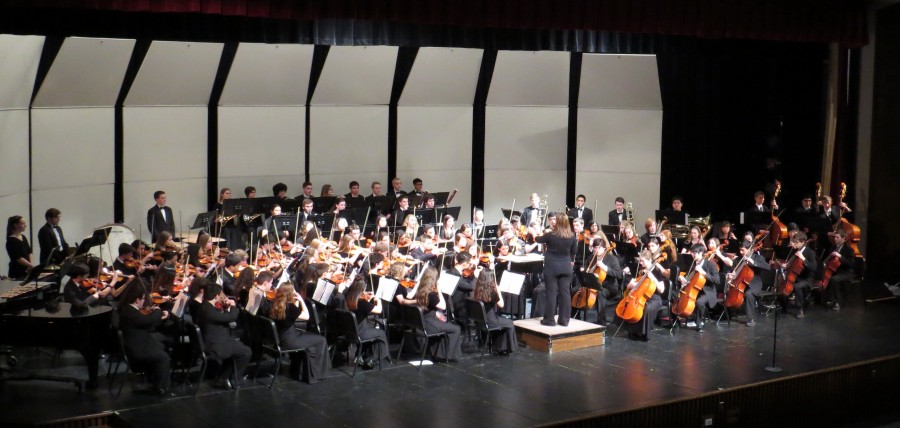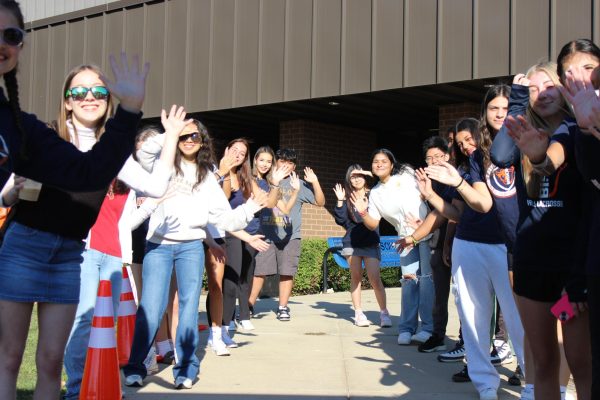The Fine Arts: refining today’s youth
Orchestra sets up for the piece “Danse Bacchanale” at concert in the theatre.
Being involved in a fine art throughout one’s high school career does more than provide an outlet for creativity; it helps students become overachievers academically, boosting potential for college acceptance.
In colleges across the board, acceptance criteria has become stricter, looking not only for students who have a high GPA and decent ACT scores, but also for extracurricular involvement in fine arts activities. One of the best ways to attract attention from a student’s favored institution is to participate in a fine art such as orchestra, band, Expressions or Orchesis.
“Not every college looks for extra involvement, but for those that do, the fine arts can do as much to boost your acceptance chances just like being an athlete can,” College Career Counselor Kathy Fox said.
Now, take a moment to think about playing an instrument, dancing or singing. Then, imagine how much effort people who participate in these activities put in on a daily basis.
“When you do something that requires a lot of time and effort, your time management automatically improves,” Fox said. “[When a student in the fine arts] has a lot of homework that isn’t due until the following week, he or she knows not to put it off, because he or she already has enough to fill their schedule.”
Work in the Fine Arts department isn’t just something done in class; there is always more work to be done outside of school.
“In Orchestra, there is a significant amount of rehearsal during class, but we are encouraged to take our instruments home and practice as well,” senior violinist Elizabeth Daulton said.
The participation of students every day already exhibits their dedication, but all of the skills they learn along the way exhibits their ability to collaborate with others and be punctual, which can help them in the future. According to The Washington Post, children involved in fine arts activities learn ten specific skills, and the first and most important on the list is non–verbal communication.
Another skill taught to fine arts students is the ability to collaborate with others.
“It’s not just college acceptance that teens need to be on the lookout for,” Fox said. “It’s also about building a work ethic for when they get a job. One of the main things employers look for is the ability to collaborate with others.”
Sometimes, musicians work together without realizing it. When students practice, it doesn’t just improve their musical ability—it improves the overall quality of the group.
“Practicing absolutely helps our group a great deal,” Daulton said. “When one of us doesn’t practice, it shows, so if everyone in the group would practice at least 30 minutes a day, the overall performance quality would be fantastic.”
According to Daulton, the ensemble can prove to be a little trickier whenever the members of Symphonic Band are added into the mix.
“I love having the band come rehearse with us,” Daulton said. “They give us an idea of what the piece is supposed to sound like as a whole, however it can be an adjustment when they come in because it just sounds different.”
This communication, in turn, challenges the band’s practices as well. The participants develop a sense of time management after being given double the amount of music to memorize in a short period of time. Not every member of the band is used to the sound of a stringed instrument flowing before them either, as the sounds of woodwind, brass and percussion combine.
Lucy Jang, a sophomore flutist in Symphonic Band and Orchestra, supports this statement.
“I’m used to just playing with a clarinet, oboe, tuba or something sounding off around me,” Jang said.
The kids in band switch between rooms and teachers a few times a week when they take part in both groups, and they have to put in extra time for practice whenever they blend with one another. As a result, the varying ensembles feed off of each other, and seem to become one throughout this process of creating music.
What was once two different musical ensembles is now one, and the music seems to flow from the instruments almost effortlessly. However, even though they seem to become one during a concert, there is still a great deal of effort that goes into the process of creating music.
Considering the fact that the band students have to listen to the opinions of various instructors from day to day, their ability to adapt is an extraordinary characteristic.
“It’s a pretty big adjustment to switch from Orchestra to Band throughout the week,” Jang said. “Practicing helps us all keep up. You just can’t confuse the directions from one teacher with directions from another, otherwise you’ll just confuse yourself.”
Music enables a student to do multiple things at once, such as reading music while feeling a rhythm and playing an instrument. It helps the development not only of one’s character, but also of his or her coordination.
“Playing the music the way these students do actually requires them to use both sides of their brain,” Fox said. “The arts are a great opportunity to further develop yourself, and it definitely is a way to benefit yourself as a person.”






